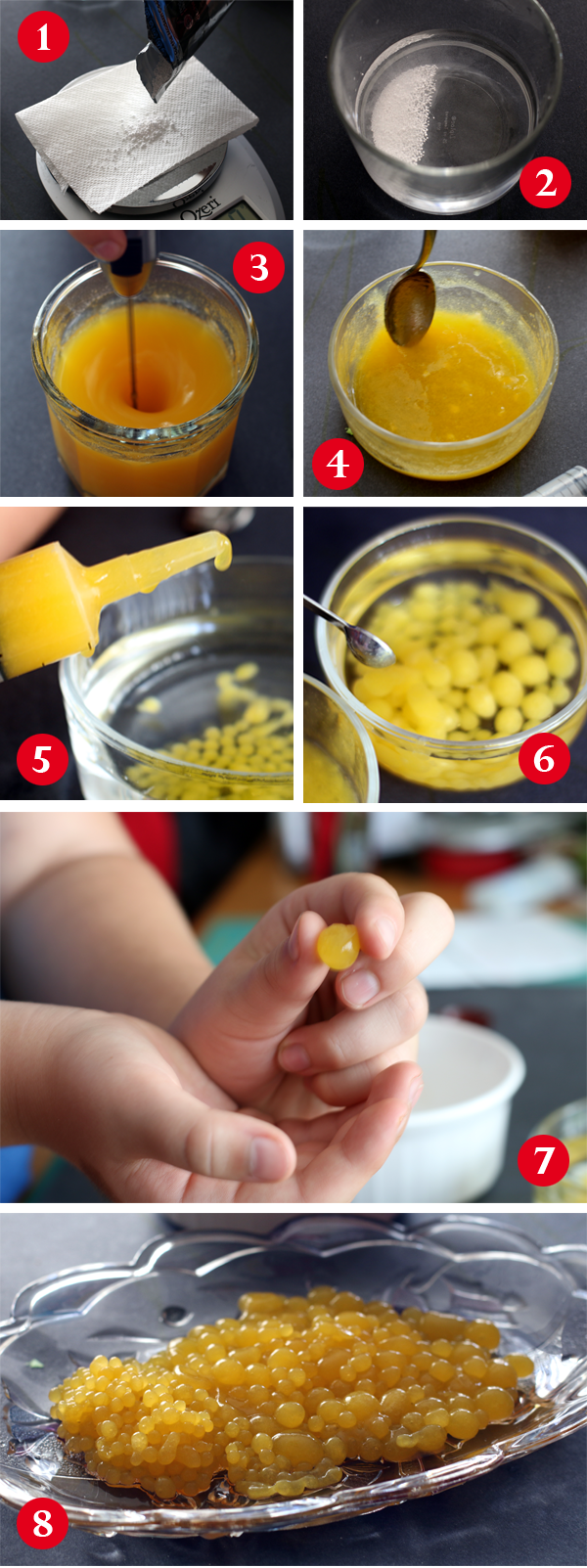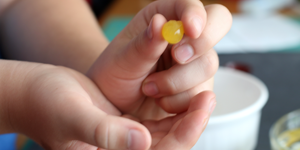Making Juice-filled Boba with a Spherification Science Project
We go DIY with molecular gastronomy and family science as we make our own popping boba using the Science Buddies Spherification Kit.

When it is hot outside, my kids love to pit stop at the nearby frozen yogurt shop where they can swirl frozen yogurt into an oversized paper bowl and load it up with toppings of their choice. Favorite toppings vary, but one kid's heaping concoction always includes little slippery, fruit-flavored balls—popping boba.
Popping boba are similar to the boba found in bubble (or boba) tea, but the small spheres have a very thin exterior skin, are filled with juice (or something similar), and "pop" in your mouth when you squeeze or bite them. In my house, the fascination with popping boba is so strong, and the availability at the yogurt shop so variable, that we ended up ordering popping boba in bulk.
We now have close to thirty pounds of the little liquid-filled balls sitting in giant plastic containers at the house!
Cool Home Science
Just about the time I was unpacking all that boba, the Spherification Kit became available. I knew the molecular gastronomy spherification process is used in a human biology project that lets students explore how blood clots. In that science project, students use spherification to simulate and explore the clotting process—and to better understand what happens when clotting doesn't work properly. But I hadn't realized when reviewing the project on hemophilia and clotting that the same process used in the Science Buddies project to help students better understand a core biological process is actually a technique more commonly used to make something edible—tasty treats referred to as "spherification caviar" that can be eaten alone, added to desserts, or even used in drinks.
From juice-filled spherification caviar to spheres of sauces, honey, and even solid foods, many cooks use spherification to add something flavor-filled and unexpected to their dishes.
As I read the product information describing the Spherification kit and took a look at the brand new Make Popping Boba Balls Out of Your Drinks project that involves spherification, I realized that what students make in the project is very, very similar to popping boba.
Making Boba
My fifth-grade student was excited to try making boba at home. We didn't do the spherification project as a science fair experiment, so we were not running trials based on the amount of sodium citrate added to our liquid solution (our "filling"). Even so, we knew from talking about the spherification project and process that not all liquids respond to spherification the same, in part because of their pH. Since fresh squeezed orange juice is what my student wanted to try for our foray into boba making, pH was a definite concern. The typical pH of orange juice is low, around 3.5, which makes it fairly acidic. (Tip: research the pH of other juices and drinks with your kids to find out how they compare! You can learn more about the pH scale here.)
For the spherification process to work with orange juice, we knew that we might need to lower the acidity of the juice by adding small amounts of sodium citrate to the mixture and seeing how well the spheres formed. (We also knew that even if spheres didn't form, we could inject strings of solution into the calcium bath and fish out something similar to gummy worms! Nothing you drop into the calcium bath is really going to be wasted... it just may or may not make a sphere.)
With that in mind, we got out our ingredients, opened the Science Buddies project up on a tablet for reference, and got down to some serious boba-making business.
Sizing Boba
Our spherification attempts were lots of fun, and as is often the case with home science activities, we tried a number of things, observed what happened with each change we made, and branched out and tried some unexpected things as well. We were amazed to see that dropping a drop of juice from the syringe into the calcium bath almost instantly formed a sphere. Excited by our immediate spherical success, we dropped several in (one by one), waited the 60 seconds, fished them out, and put them to the taste test. Because we hadn't rinsed them, they were a bit saltier than we expected (but still totally safe to eat). But, they worked! They were very much like popping boba—and filled with fresh orange juice. Very cool!
They were tiny.
Seriously tiny.
But they were juice-filled spheres, and they did pop in our mouths.
Using the syringe, we made several bowls of homemade popping boba. We played around with our solution, experimenting to see what difference differing amounts of sodium citrate might make. We made some gummy worms.
And then we got creative. The biggest disappointment for us was the small size of the caviar spheres. How could we make them bigger? What would happen if we dropped our juice into the mix by something larger, like a very small measuring spoon? We experimented with several differently sized spoons and techniques, and, voila, we ended up with larger boba.
The process was a huge hit, and we will definitely try spherification again. We have other questions we want to answer, and using a different kind of juice or drink will let us see how the process changes based on what food or liquid we use to fill our spheres.
Try It at Home
If you have kids who love kitchen science or who are enamored with popping boba, spherification is definitely something to try at home. The kit contains enough materials to make quite a bit of boba (or other spherification caviar), so this is a project you can pull out on a rainy afternoon, with a group of kids after school, or any time. You will need some regular household supplies on hand, including bowls, access to a blender, spoons, and your filling (e.g., juice), but the process is fast, and cleanup is easy.
Here are a few tips and pointers, based on our experience, for home experimentation:
- Your juice (or filling) should be refrigerator cold before you begin. Many spherification recipes also suggest refrigerating the sodium alginate solution for several hours (to remove air bubbles). If you encounter problems making your boba, keep this in mind as something to try.
- Mixing up the juice with the sodium alginate took some doing. We tried a handheld milk frother rather than a blender, for convenience. It may not have been powerful enough, and the sodium alginate did want to clump in the liquid rather than mix. Keep at it! You want to get the solution as thoroughly mixed as you can. If you have an immersion blender, you may find it just the right tool for the task!
- Fishing the spheres, especially the super tiny ones, from our calcium bath was not easy using a regular spoon. If you have a small strainer-type spoon, or a spoon with very small slots or holes, you may find it easier to fish the balls out.
- Rinsing the balls before eating them helps remove the salty taste.
- Experiment with the angle at which you hold the syringe and how quickly you release the solution into the bath (or how forcefully you push the plunger).
- If you decide to try larger spheres, experiment with the speed at which you drop the solution into the bath.
- Keep in mind that boba made this way should be eaten shortly after making them. They will continue to harden!
Watch the Video
If your home trials lead your kids to ask further questions about boba and how companies make lots of boba, you may enjoy watching a video like this one, which shows a tool that can be used to create uniform spherification caviar in batches (see screenshot below). You may also want to look around online at some of the many cool and exciting recipe ideas you will find for spherification caviar. Juice is only the beginning!
Reverse Spherification
In your research on spherification and molecular gastronomy, you will also see "reverse spherification" mentioned and noted in some recipes. This is a process used when trying to encapsulate foods that contain calcium. Stay tuned for a Science Buddies project on making "yogurt ravioli" using reverse spherification!
You Might Also Enjoy These Related Posts:
- 15 STEM Gifts & Science Kits You'll Feel Good About Giving
- 13 Boat Science and Submarine Science Projects and Experiments
- July 4th STEM! Summer Science Picks for Independence Day!
- 12 Science Kits for Summer Science Experiments and Discovery
- 15 Science Projects to Make and Give for Father's Day
- Ready, Set, Go! (Awesome Summer Science Experiments)
- Awesome Summer Science Experiments
- 10 STEM Activities with Cardboard Tubes











